Convolutional Neural Network Example
Build a convolutional neural network with TensorFlow.
This example is using TensorFlow layers API, see 'convolutional_network_raw' example for a raw TensorFlow implementation with variables.
- Author: Aymeric Damien
- Project: https://github.com/aymericdamien/TensorFlow-Examples/
CNN Overview

MNIST Dataset Overview
This example is using MNIST handwritten digits. The dataset contains 60,000 examples for training and 10,000 examples for testing. The digits have been size-normalized and centered in a fixed-size image (28x28 pixels) with values from 0 to 1. For simplicity, each image has been flattened and converted to a 1-D numpy array of 784 features (28*28).
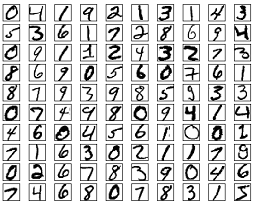
More info: http://yann.lecun.com/exdb/mnist/
from __future__ import division, print_function, absolute_import
# Import MNIST data
from tensorflow.examples.tutorials.mnist import input_data
mnist = input_data.read_data_sets("/tmp/data/", one_hot=False)
import tensorflow as tf
import matplotlib.pyplot as plt
import numpy as np
Extracting /tmp/data/train-images-idx3-ubyte.gz
Extracting /tmp/data/train-labels-idx1-ubyte.gz
Extracting /tmp/data/t10k-images-idx3-ubyte.gz
Extracting /tmp/data/t10k-labels-idx1-ubyte.gz
# Training Parameters
learning_rate = 0.001
num_steps = 2000
batch_size = 128
# Network Parameters
num_input = 784 # MNIST data input (img shape: 28*28)
num_classes = 10 # MNIST total classes (0-9 digits)
dropout = 0.25 # Dropout, probability to drop a unit
# Create the neural network
def conv_net(x_dict, n_classes, dropout, reuse, is_training):
# Define a scope for reusing the variables
with tf.variable_scope('ConvNet', reuse=reuse):
# TF Estimator input is a dict, in case of multiple inputs
x = x_dict['images']
# MNIST data input is a 1-D vector of 784 features (28*28 pixels)
# Reshape to match picture format [Height x Width x Channel]
# Tensor input become 4-D: [Batch Size, Height, Width, Channel]
x = tf.reshape(x, shape=[-1, 28, 28, 1])
# Convolution Layer with 32 filters and a kernel size of 5
conv1 = tf.layers.conv2d(x, 32, 5, activation=tf.nn.relu)
# Max Pooling (down-sampling) with strides of 2 and kernel size of 2
conv1 = tf.layers.max_pooling2d(conv1, 2, 2)
# Convolution Layer with 64 filters and a kernel size of 3
conv2 = tf.layers.conv2d(conv1, 64, 3, activation=tf.nn.relu)
# Max Pooling (down-sampling) with strides of 2 and kernel size of 2
conv2 = tf.layers.max_pooling2d(conv2, 2, 2)
# Flatten the data to a 1-D vector for the fully connected layer
fc1 = tf.contrib.layers.flatten(conv2)
# Fully connected layer (in tf contrib folder for now)
fc1 = tf.layers.dense(fc1, 1024)
# Apply Dropout (if is_training is False, dropout is not applied)
fc1 = tf.layers.dropout(fc1, rate=dropout, training=is_training)
# Output layer, class prediction
out = tf.layers.dense(fc1, n_classes)
return out
# Define the model function (following TF Estimator Template)
def model_fn(features, labels, mode):
# Build the neural network
# Because Dropout have different behavior at training and prediction time, we
# need to create 2 distinct computation graphs that still share the same weights.
logits_train = conv_net(features, num_classes, dropout, reuse=False, is_training=True)
logits_test = conv_net(features, num_classes, dropout, reuse=True, is_training=False)
# Predictions
pred_classes = tf.argmax(logits_test, axis=1)
pred_probas = tf.nn.softmax(logits_test)
# If prediction mode, early return
if mode == tf.estimator.ModeKeys.PREDICT:
return tf.estimator.EstimatorSpec(mode, predictions=pred_classes)
# Define loss and optimizer
loss_op = tf.reduce_mean(tf.nn.sparse_softmax_cross_entropy_with_logits(
logits=logits_train, labels=tf.cast(labels, dtype=tf.int32)))
optimizer = tf.train.AdamOptimizer(learning_rate=learning_rate)
train_op = optimizer.minimize(loss_op, global_step=tf.train.get_global_step())
# Evaluate the accuracy of the model
acc_op = tf.metrics.accuracy(labels=labels, predictions=pred_classes)
# TF Estimators requires to return a EstimatorSpec, that specify
# the different ops for training, evaluating, ...
estim_specs = tf.estimator.EstimatorSpec(
mode=mode,
predictions=pred_classes,
loss=loss_op,
train_op=train_op,
eval_metric_ops={'accuracy': acc_op})
return estim_specs
# Build the Estimator
model = tf.estimator.Estimator(model_fn)
INFO:tensorflow:Using default config.
WARNING:tensorflow:Using temporary folder as model directory: /tmp/tmpdhd6F4
INFO:tensorflow:Using config: {'_save_checkpoints_secs': 600, '_session_config': None, '_keep_checkpoint_max': 5, '_tf_random_seed': 1, '_keep_checkpoint_every_n_hours': 10000, '_log_step_count_steps': 100, '_save_checkpoints_steps': None, '_model_dir': '/tmp/tmpdhd6F4', '_save_summary_steps': 100}
# Define the input function for training
input_fn = tf.estimator.inputs.numpy_input_fn(
x={'images': mnist.train.images}, y=mnist.train.labels,
batch_size=batch_size, num_epochs=None, shuffle=True)
# Train the Model
model.train(input_fn, steps=num_steps)
INFO:tensorflow:Create CheckpointSaverHook.
INFO:tensorflow:Saving checkpoints for 1 into /tmp/tmpdhd6F4/model.ckpt.
INFO:tensorflow:loss = 2.39026, step = 1
INFO:tensorflow:global_step/sec: 238.314
INFO:tensorflow:loss = 0.237997, step = 101 (0.421 sec)
INFO:tensorflow:global_step/sec: 255.312
INFO:tensorflow:loss = 0.0954537, step = 201 (0.392 sec)
INFO:tensorflow:global_step/sec: 257.194
INFO:tensorflow:loss = 0.121477, step = 301 (0.389 sec)
INFO:tensorflow:global_step/sec: 255.018
INFO:tensorflow:loss = 0.0539927, step = 401 (0.392 sec)
INFO:tensorflow:global_step/sec: 254.293
INFO:tensorflow:loss = 0.0440369, step = 501 (0.393 sec)
INFO:tensorflow:global_step/sec: 256.501
INFO:tensorflow:loss = 0.0247431, step = 601 (0.390 sec)
INFO:tensorflow:global_step/sec: 252.956
INFO:tensorflow:loss = 0.0738082, step = 701 (0.395 sec)
INFO:tensorflow:global_step/sec: 253.222
INFO:tensorflow:loss = 0.134998, step = 801 (0.395 sec)
INFO:tensorflow:global_step/sec: 255.606
INFO:tensorflow:loss = 0.00438448, step = 901 (0.391 sec)
INFO:tensorflow:global_step/sec: 256.306
INFO:tensorflow:loss = 0.0471991, step = 1001 (0.390 sec)
INFO:tensorflow:global_step/sec: 255.352
INFO:tensorflow:loss = 0.0371172, step = 1101 (0.392 sec)
INFO:tensorflow:global_step/sec: 253.277
INFO:tensorflow:loss = 0.0129522, step = 1201 (0.395 sec)
INFO:tensorflow:global_step/sec: 252.49
INFO:tensorflow:loss = 0.039862, step = 1301 (0.396 sec)
INFO:tensorflow:global_step/sec: 253.902
INFO:tensorflow:loss = 0.0520571, step = 1401 (0.394 sec)
INFO:tensorflow:global_step/sec: 255.572
INFO:tensorflow:loss = 0.0307549, step = 1501 (0.392 sec)
INFO:tensorflow:global_step/sec: 254.32
INFO:tensorflow:loss = 0.0108862, step = 1601 (0.393 sec)
INFO:tensorflow:global_step/sec: 255.62
INFO:tensorflow:loss = 0.0294434, step = 1701 (0.391 sec)
INFO:tensorflow:global_step/sec: 254.349
INFO:tensorflow:loss = 0.0179781, step = 1801 (0.393 sec)
INFO:tensorflow:global_step/sec: 255.508
INFO:tensorflow:loss = 0.0375271, step = 1901 (0.391 sec)
INFO:tensorflow:Saving checkpoints for 2000 into /tmp/tmpdhd6F4/model.ckpt.
INFO:tensorflow:Loss for final step: 0.00440777.
<tensorflow.python.estimator.estimator.Estimator at 0x7fb80ca55c90>
# Evaluate the Model
# Define the input function for evaluating
input_fn = tf.estimator.inputs.numpy_input_fn(
x={'images': mnist.test.images}, y=mnist.test.labels,
batch_size=batch_size, shuffle=False)
# Use the Estimator 'evaluate' method
model.evaluate(input_fn)
INFO:tensorflow:Starting evaluation at 2017-08-21-14:25:29
INFO:tensorflow:Restoring parameters from /tmp/tmpdhd6F4/model.ckpt-2000
INFO:tensorflow:Finished evaluation at 2017-08-21-14:25:29
INFO:tensorflow:Saving dict for global step 2000: accuracy = 0.9908, global_step = 2000, loss = 0.0382241
{'accuracy': 0.99080002, 'global_step': 2000, 'loss': 0.038224086}
# Predict single images
n_images = 4
# Get images from test set
test_images = mnist.test.images[:n_images]
# Prepare the input data
input_fn = tf.estimator.inputs.numpy_input_fn(
x={'images': test_images}, shuffle=False)
# Use the model to predict the images class
preds = list(model.predict(input_fn))
# Display
for i in range(n_images):
plt.imshow(np.reshape(test_images[i], [28, 28]), cmap='gray')
plt.show()
print("Model prediction:", preds[i])
INFO:tensorflow:Restoring parameters from /tmp/tmpdhd6F4/model.ckpt-2000
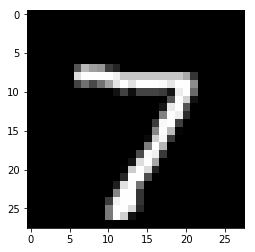
Model prediction: 7
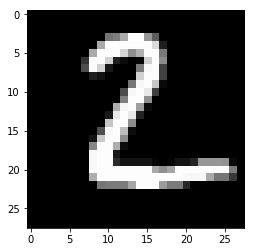
Model prediction: 2
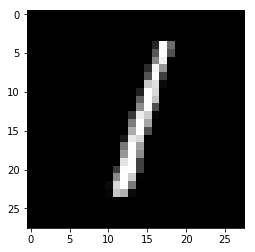
Model prediction: 1
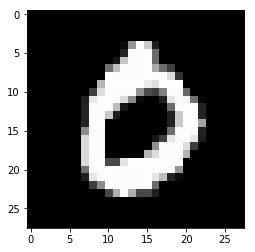
Model prediction: 0